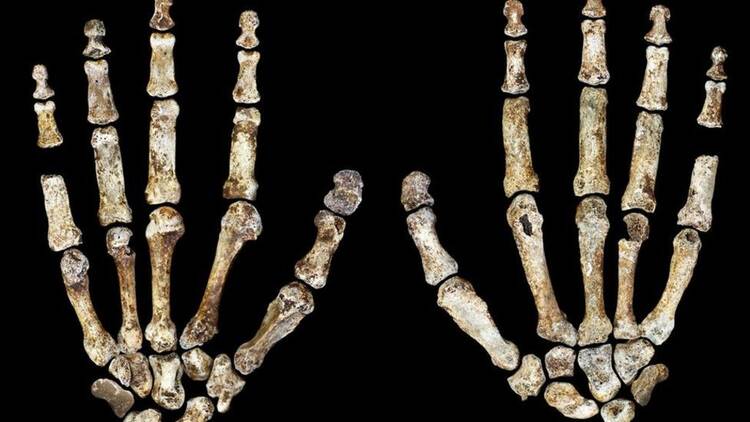Scientists in South Africa have discovered a new hominin species in a cave some 40 kms west of the city of Johannesburg. Acting on a tip off from some spelunkers two years ago (who saw bones through a crack in a limestone wall), scientists discovered a large dark chamber in which the skeletons of previously unidentified species of early human lineage were buried. The species has been named Homo “naledi”—which means “star” in the local Sesotho language. A team of cavers had to fit through an 18-centimetre wide hole and climb down a metre vertical passage in very dangerous conditions to remove the fossils.
The discovery of the 15 partial skeletons is the largest of its type in Africa. The discovery will, researchers claim, change our ideas about early human ancestors. The announcement of the find was made on Thursday at the “Cradle of Humankind” in Maropeng. An international team of more than 60 scientists was led by Prof. Lee R. Berger, an American paleoanthropologist who is professor of human evolution studies at Johannesburg’s University of the Witwatersrand. Berger told those gathered at the announcement of the find, that that almost every bone in the body of naledi had been found multiple times. This makes Homo naledi “practically the best-known fossil member of our lineage,” Prof. Berger said.
The researchers that found the fossils have not been able to say just how long ago these creatures lived. Prof. Berger believes they could be among the first of our kind (genus homo) and could have lived in Africa up to three million years ago. Berger said that naledi could be thought of as a “bridge” between more primitive bipedal primates and humans. Berger said that they went in with the idea that they would recover one fossil. “That turned into multiple fossils. That turned into the discovery of multiple skeletons and multiple individuals,” he said.
“And so by the end of that remarkable 21-day experience, we had discovered the largest assemblage of fossil humans ever discovered in the history of the continent of Africa. That was an extraordinary experience.”
Prof. Chris Stinger of the Natural History Museum said that the discovery was very important because it suggests that nature was experimenting with how to evolve humans, thus giving rise to several different types of human-like creatures originating in parallel in different parts of Africa. “Only one line survived to give rise to us,” Stinger said. Homo naledi is a bit smaller and a lot older than we are, with curved fingers and a small skull, but in some ways the species is also strikingly similar to humankind.
Up until now our knowledge of early humans was based on partial skeletons and the occasional skull. The haul of 15 skeletons, which includes both male and female of varying ages, from infants to elderly, is unprecedented in Africa and will shed more light on how the first humans evolved. The discovery suggests some other fascinating things. An intriguing question, for example, is how the remains got to where they were discovered. It seems as if these early hominins intentionally buried the bodies of their dead in a remote and largely inaccessible cave chamber. This kind of behaviour was previously considered to be the conduct of modern humans (homo sapiens) only. Some of the scientists suggests that the hominins could have had a “ritualized practice” when burying their dead. By “ritual” they said they mean a deliberate and repeated practice, not necessarily a kind of religious rite.
There are also other striking similarities between naledi and us. Prof. John Hawks explained some of them. “The foot which was found complete in articulation in the deposit, the other foot evidence we have from multiple individuals, shows a very human like foot anatomy. A foot that is very difficult to distinguish in any ways from our own. It’s very clear that the legs and feet of Homo naledi were made for a long distance and effective walking.”
At the announcement of the discovery Prof. Berger said, “It gives me goose bumps, it’s so inspiring, and I feel really proud. It means a lot to every human being around the world.” Vice-Chancellor of the University of the Witwatersand, Prof. Adam Habib, who was present at the announcement, said that the discovery would have “a global momentous impact.”








